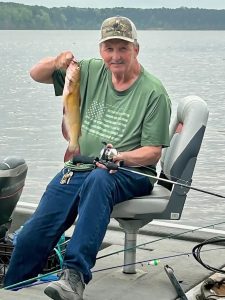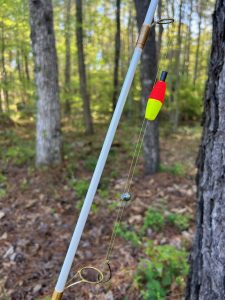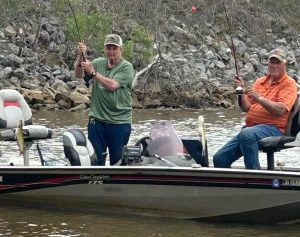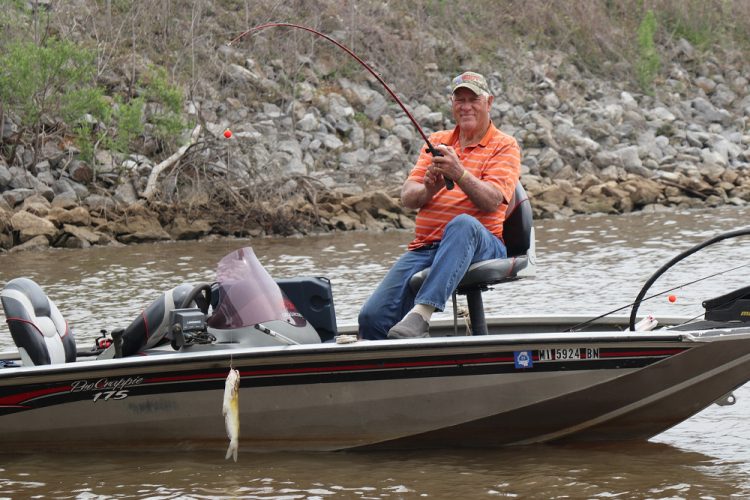Sonny Russell displays a fish he caught in the rocks at Okatibbee’s Upper Lake Causeway. Small eating-size cats like this comprise most of the catch for anglers fishing the riprap here.
Fishing Okatibbee
Story and photos by Michael O. Giles
Catching catfish on the rocks.
Sonny Russell and Kenny Wayne Snowden launched their boat on east-central Mississippi’s Okatibbee Lake, made a short run to the upper-lake causeway and started fishing. Both anglers baited up and made a cast before their boat wake had subsided.
Wham! A hungry channel catfish nailed Russell’s bait, and the cork disappeared like a submarine. Russell set the hook and landed the feisty catfish in short order.

Before Russell could get his fish unhooked, Snowden nailed his first fish of the day. The catfish were spawning along riprap rocks, and the two anglers caught catfish for the next 30 minutes before the action slowed.
Russell and Snowden are friends and lifelong anglers who love fishing during the channel catfish spawn on Okatibbee every year. When the time is right, cats in this 11,000-acre Army Corps of Engineers impoundment just north of Meridian head to the rocks, and this dynamic duo is there when it happens.
“The catfish spawn runs from mid-April through the month of May, depending on the current weather conditions,” said Russell. “On a good morning, we’ll catch 40 to 50 cats, and if they’re biting really good, we may fish eight or nine hours until the bite slows. On those days, it’s not uncommon for us to catch over 100 catfish, although we don’t usually like to clean that many fish in one sitting.”
“I love to fish, but I like catching better and there’s no better time to catch eating-sized catfish than during the spawn,” Snowden said. “The catfish spawn on the rocks just like crappie do. But they usually spawn after the peak of the crappie spawn. If you want to keep catching good-tasting fish, then just switch your baits from jigs to minnows and worms and you should have about the same catch rate.
“We use the same light-tackle rod-and-reel combos that we catch spawning crappie on,” Snowden continued. “I prefer light rods with Zebco-style reels, while Sonny likes to use lightweight open-face combos. Both style setups give you some great action on catfish from 1 to 3 pounds, with an occasional 6- to 7-pounder caught. A lot of times, we will get a bite the minute the bait hits the water, so you need to be ready. Some days we
find them right on the bank, and other days they might be a little deeper out by our boat, which is usually about a cast off the bank.”

Snowden noted that one of them will start shallow, say about a foot deep, while the other angler starts out fishing about three feet deep. If either one starts catching catfish, then the other will adjust their cork to the catfish’s preferred depth.
“Once we find the right depth, we will key on that level and try similar spots around the lake,” he said. “Sometimes they may be in a place the size of a five-gallon bucket, and other days they’re scattered along the rocks. So, you just need to keep an open mind every time you go.”
The two anglers prefer a setup with a lead-weighted cork that allows them to cast right to the spot they want to fish.
“We use 10- to 12-pound line with a small circle hook or a 1/0 J hook,” Snowden said. “We also prefer Canadian wiggler baits for channel catfish.”
“I’ll put a swivel just above the hook so that the catfish won’t be able to twist the line and tear the hook out,” said Russell. “We also use a dip net to save some of them that might normally twist and tear off, too.
“Although we like the upper-lake causeway the best, anglers can have as much success on some of the riprap rocks by the Gin Creek and Collinsville landings, as well as the rocks along the dam and emergency spillway,” he added. “You might catch them spawning on any riprap banks around the lake, but we have our favorite spots we try first.”
The key to catching spawning catfish is to keep moving down the rocks if you’re not getting bites.
“We’ll keep working down the rocks until we get a bite and then fish that area,” Russell said. “We may catch one or two or 10 or 12, but if they get slow, we keep moving because they will be scattered all along the rocks. If you keep moving, you may find one of our honeyholes with 25 to 30 catfish together. That’s what we fish for, and it’s a lot of fun when you get on them right.”

Other Mississippi lakes like Ross Barnett, Sardis, Grenada and Enid have a lot of riprapped banks that offer the same type spawning areas as Okatibbee. Anglers catch crappie and catfish on those rocks when the time is right, also.
Much like Okatibbee Lake, it’s a matter of fishing the lakes and finding the best spots for spawning catfish. But the key is to fish the rocks if you want to catch catfish during the spawn.
“I don’t know why, but the catfish we catch on Okatibbee Lake are much better tasting than any I’ve caught from a pond or ate at a fish house,” said Snowden. “Okatibbee is a flood-control lake, and the water flows through pretty much all the time during the winter and spring. That may be a key because the water never gets stagnant.”
“I’ll eat the catfish whole if they’re less than a pound,” Russell said. “I fillet those that are 2 or 3 pounds and fry them up. They are really good and provide us with tasty fish all year long.”
If you are looking for fast paced spawning action, then try Okatibbee Lake or similar lakes around the state and get ready for some fantastic spawning action and good eating! For more info, visit okatibbeelake.com.
(Michael Giles of Meridian, Mississippi is an avid bass and crappie angler and part-time guide. He’s also an award-winning wildlife photographer, author and writer who has been fishing and hunting since 1965.)



